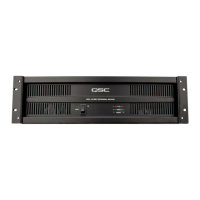Technical Service Manual 19
ISA Series Power Amplifiers
3.4 Instability
The customer complains of gain problems, spurious noises, or oscilla-
tions.
Symptoms covered:
• General output distortion
• “Ringing” sound in loudspeaker trailing an audio signal
• Excessive crossover distortion
• The output waveform appears fuzzy on an oscilloscope
Distinguish among the different symptoms of fuzziness (instability),
ringing (momentary instability after a transition), crossover
distortion (often causing ringing), or general distortion.
Possible situations:
General distortion in the output signal
• Severe distortion, at any load, often with abnormally high
current draw: check the slew rate capacitors C114, C115, and
C116 (Channel 1) or C214, C215, and C216 (Channel 2).
• Moderate distortion, especially with light loading: stability
capacitors C124 and C126 (Channel 1) or C224 and C226 is too
high in capacitance; also check the slew rate capacitors C114,
C115, and C116 (Channel 1) or C214, C215, and C216 (Channel
2), and the output filter resistors R161, R162, R154, and R155
(Channel 1) or R261, R262, R254, or R255 (Channel 2).
• Distortion with low gain: check the feedback shunt components
R120, R138, and C125 (Channel 1) or R220, R238, or C225
(Channel 2); also check for broken circuit traces around the
components; U101 (Channel 1) or U201 (Channel 2) is defective
or its socket is contaminated.
Ringing sound trailing the audio signal
• This usually indicates marginal instability and is usually
triggered by the signal passing through zero volts (the crossover
point). Check the stability components and output filters.
• With a sine wave test signal, use an oscilloscope to check for
excessive crossover notch at the output signal’s zero crossings.
Excessive crossover distortion (unbalanced, asymmetrical,
or excessively large crossover notch)
• Severe crossover discontinuity: bias diodes D108 or D109
(Channel 1) or D208 or D209 (Channel 2) are shorted.
• Moderate discontinuity: bias diodes D108 or D109 (Channel 1)
or D208 or D209 (Channel 2) are out of spec.
• R131 (Channel 1) or R231 (Channel 2) is defective.
• Base resistors R136 or R137 (Channel 1) or R236 or R237
(Channel 2) are open. Also check the NTC thermistors R134
(Channel 1) or R234 (Channel 2).
3.5 Power supply & rail balancing
problems
Symptoms covered:
• Insufficient or excessive current limiting into a shorted load
• Op amp rails too high with a shorted load
• Uneven voltages on supply rails
A channel’s output current should remain unaffected when driving
resistive loads as low as 2 ohms per channel. When driving a short
circuit, the current limiting circuit should collapse the output to a
lower current. This is done by dropping the op amp’s supply rails
from a normal ±14–15 volts down to about ±5–6 volts. Normally,
the output signal helps replenish the op amp supply rails through
D115 and D116 (Channel 1) and D215 and D216 (Channel 2), but a
short circuit or excessively low load impedance prevents the
replenishment, and the op amp rails collapse because they can’t
supply enough current to let the op amp drive both the clip LED and
the driver transistors. The current limit trimpots R139, R140, R239,
and R240 permit adjustment of the current limit thresholds. See
the RMX calibration section of this manual for adjustment
procedures.
Possible situations:
Excessive current into short (insufficient limiting)
• If the op amp rails are dropping to ±5 to 6 volts as they should:
the 5.6V zener diodes D107 and/or D110 (Channel 1) or D207
and/or D210 (Channel 2) are reversed or shorted.
• If high crossover distortion is present: bias diodes D108 or D109
(Channel 1) or D208 or D209 (Channel 2) are shorted.
Excessive current into short (op amp rails are not drop-
ping)
• The op amp U101 (Channel 1) or U201 (Channel 2) is defective,
with insufficient output current.
• Clip LED LD100 (Channel 1) or LD200 (Channel 2) and/or its
rectifying diodes (Channel 1: D102, D103, D105, D106; Channel 2:
D202, D203, D205, D206) are open.
• When driving a short circuit, the output section’s positive and
negative supply rail voltages should be equal, within 3 volts. If
they aren’t, check D107, D110, R146, and R147 (Channel 1) or
D207, D210, R246, and R247 (Channel 2).
Weak current into 2
ΩΩ
ΩΩ
Ω or short (excessive or premature
limiting)
• Bias resistors R130 and R132 (Channel 1) or R230 and R232
(Channel 2) are too high.
• Driver transistors (Channel 1: Q105, Q106; Channel 2: Q205,
Q206) have very low gain.
• One or more emitter resistors in the output section are open.
Current OK at 2
ΩΩ
ΩΩ
Ω, weak into short
• LD100, D102, D103, D105, or D106 (Channel 1), or LD200, D202,
D203, D205, or D206 (Channel 2), are shorted.
• Zener voltage of diodes D107 or D110 (Channel 1), or D207 or
D210 (Channel 2), is too high.

